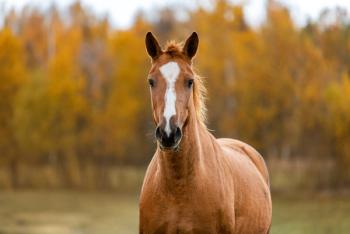
EHV-1 outbreak dwindles, only three new cases reported this week
National Report -- There have been no reports of new equine herpesvirus (EHV-1) cases originating from a Utah cutting horse event in the last week, veterinarians report, and new cases from secondary exposures have trickled to three.
National Report
— There have been no reports of new equine herpesvirus (EHV-1) cases originating from a Utah cutting horse event in the last week, veterinarians report, and new cases from secondary exposures have trickled to three.
Of the 88 total confirmed cases of EHV-1/equine herpesvirus myeloencephalopathy (EHM), 58 of the infected horses attended the National Cutting Horse Association (NCHA) competition in Ogden, Utah, between April 29 to May 8, as reported in
DVM Newsmagazine
.
In total, three new cases have surfaced since a government update on the outbreak last week—a major drop from the 13 new cases reported the prior week and the 15 the week before—and all of those from secondary or tertiary exposure, according to data released yesterday from the United States Department of Agriculture's Animal and Plant Health Inspection Service (APHIS).
Over the last week, EHV-1 primary exposures have remained steady at 32, and EHM primary cases remained at 26 total.
EHV-1 secondary cases increased by six to a total of 23 cases, and EHM cases increased by one to a total of seven cases, APHIS reports.
More than 400 horses in 19 states were exposed to the virus at the Utah event, and another 1,685 have been exposed by association, APHIS says. In addition, 12 horses either died or were euthanized as result this outbreak.
Several state veterinary officials reported that they would continue to monitor secondary exposure cases until June 5. While the incubation period for EHV-1 is two to 14 days, the virus can shed for up to 28 days, veterinarians say.
APHIS says horses known to have been exposed to the virus have been notified by state animal health officials, and suspect or confirmed cases are under voluntary or state quarantine.
As of June 8, here are USDA's totals on the outbreak:
• Arizona — 2 EHV-1 and 1 EHM from direct exposure, 10 EHV-1 and 1 EHM from secondary/tertiary exposure;
• California — 9 EHV-1 and 7 EHM from direct exposure, 4 EHV-1 and 1 EHM from secondary/tertiary exposure;
• Colorado — 9 EHV-1 and 6 EHM from direct exposure, 1 EHV-1 from secondary/tertiary exposure;
• Idaho — 1 EHV-1 and 2 EHM from direct exposure, 3 EHV-1 and 2 EHM from secondary/tertiary exposure;
• Nevada — 1 EHV-1 from direct exposure, 2 EHM from secondary/tertiary exposure;
• New Mexico — 2 EHV-1 and 1 EHM from direct exposure, 1 EHM from secondary/tertiary exposure;
•Oklahoma — 1 EHM from direct exposure;
• Oregon — 2 EHV-1 and 1 EHM from direct exposure, 2 EHM from secondary/tertiary exposure;
• Utah — 1 EHV-1 and 4 EHM from direct exposure, 3 EHV-1 from secondary/tertiary exposure;
• Washington — 5 EHV-1 and 3 EHM from direct exposure.
Ten horses with confirmed cases of EHV-1/EHM through direct exposure died or were euthanized, plus another two horses with confirmed cases contracted through secondary exposure.
More than 240 horse facilities have been exposed across the Western states, with 61 reporting suspect or confirmed cases (two new this week) and 180 with no suspect or confirmed cases, says APHIS.
Horse owners are being advised to notify veterinarians if they participated in the NCHA event or if their horse suddenly comes down with a temperature above 102-degrees-F, which typically precedes clinical signs, veterinarians say.
Newsletter
From exam room tips to practice management insights, get trusted veterinary news delivered straight to your inbox—subscribe to dvm360.




